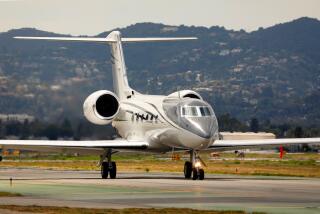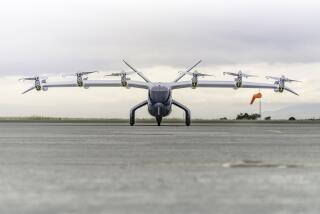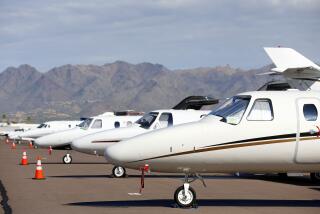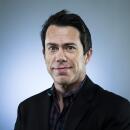AIR HOLLYWOOD
- Share via
Not long ago, following one of the purges that periodically roil the top ranks of the entertainment industry, a defrocked VIP ruminated about how much he missed his old job.
What do you miss most? a reporter asked.
Now, this erstwhile player could have pointed to the obvious perks: $30-an-entree “business” dinners . . . schmoozing endlessly with major stars.
But the axed exec was dreaming of a far grander benefit. Drawing a deep sigh, he sadly replied: “I really miss the corporate jet.”
We hear you, brother.
Or at least your Hollywood colleagues do. Because if there’s one thing the entertainment industry has really grown to love, it’s the private jet; that sexy, $30-million-plus symbol of corporate success and, some would say, excess. Moguls such as David Geffen and Barry Diller have them; so do stars such as Arnold Schwarzenegger, Tom Cruise and John Travolta, who pilots the Lear and Gulfstream II that he owns and even named his son Jett. Film studios often command fleets of three or more, shuttling top brass between the coasts or directors to scout remote locations. And celebrities find them especially useful for slipping out of town quietly, post-nuptial or pre-divorce. There’s even a cottage industry of 20 or so charter carriers in the L.A. area that cater to celebrities and other well-heeled clientele who need planes.
Travel by private jet has become such a Hollywood commonplace, in fact, that a sort of arriviste snobbery now prevails. Yes, Seagram heir and MCA chief Edgar Bronfman Jr. is first in line for the Gulfstream V, part of a new generation of business jets that can fly farther (up to 7,500 miles) and empty wallets quicker ($38 million) than its predecessors.
“The entertainment industry has been at the forefront of corporate aviation historically as far back as airplanes have existed,” says Randall Greene of Boulder, Colo.-based Aeronautical Systems Corp., a jet designer. Indeed, Mary Pickford and William Randolph Hearst, America’s and Marion Davies’ respective sweethearts, favored Vultee V1As, single-engine transport planes that could fly up to 240 mph and predated the popular DC-3.
Yet a new and much more populous breed of jet-setter flies in and out of Southern California these days. With movie salaries and the stock market soaring, stars and studio brass alike can easily afford to ditch paparazzi by stealing out of executive airports such as Santa Monica or Van Nuys. After he was caught in flagrante delicto with a Sunset Boulevard prostitute last year, Hugh Grant reportedly high-tailed it out of Burbank airport on a chartered jet. By doing so, the story goes, the actor also avoided the waiting throng on the other side of the Atlantic at London’s Heathrow Airport, landing instead at a private terminal outside the city.
Not that it would take a scandal, of course, to sour anyone on airline food or the shoving matches at baggage claim. Those indignities are easily magnified when your face is known.
For status-conscious entertainers and the people who make a living off them, there’s also what Greene refers to as “the jiggle factor.” Having a Gulfstream--generally considered to business aviation what Montecristos are to cigars--”is a benchmark on the path to success,” he says.
Some, though, have resisted the jiggle. As executives lust after shiny new toys such as Bombardier’s Global Express ($34 million), shareholders understandably fume. Besides the purchase price, private jets can easily eat up another $1 million annually in maintenance and fuel costs, charter operators say. That’s a considerable investment even for a corporate bruiser such as Walt Disney Co., which raised eyebrows earlier this year by agreeing to buy Creative Artists Agency’s Gulfstream III for its then-No. 2 man, Michael Ovitz. And Time Warner has retained a top consulting firm to scrutinize its seven-jet air force and other executive perks as part of an effort to cut millions in costs.
With the expense so high, why doesn’t management travel like everyone else? Harold Vogel, an entertainment stock analyst at the Cowen Co., has one explanation: “Companies are paying management a lot a money, and their time is valuable.”
Still, and perhaps because of its long-standing reputation for needless extravagance (in one notorious incident, then-studio chief Jon Peters dispatched a Sony jet to deliver flowers to his girlfriend in Paris), the entertainment industry is especially sensitive about corporate jets. One movie publicist explains that her clients are uncomfortable talking about them because they fear fan backlash. Jack Valenti, head of the Motion Picture Assn. of America, quickly points a finger at other big industries: “They all have ‘em, got ‘em by the long ton. The only reason you don’t hear about ‘em is because you don’t cover the asparagus growers . . .” (Valenti, for the record, says he flies commercial.)
Which is not to say that Hollywood doesn’t have ‘em by the long ton, too. Bob Trimborn, Santa Monica Airport’s manager, says that while overall traffic has tapered off since 1990, corporate jet traffic is up almost 35% in the same period, with Hollywood responsible for much of that increase. He attributes the airport’s popularity with celebrities to its proximity to Century City and Beverly Hills.
At Burbank’s airport, corporate jets often crowd the runways just before and after award shows and special sporting events. “The Grammys, the Emmys, the Academy Awards--that’s when you’re gonna see a whole lot of action” on the runway, says airport spokesman Sean McCarthy. And Las Vegas, with frequent trade shows and boxing matches, is an especially popular destination for West Coast glitterati.
Charter companies have benefited from the increased demand, with firms like Ultimate Jet in Santa Monica reporting a 100% increase in business since 1990. Services don’t come cheap: A trip from Santa Monica to New York on a Gulfstream that seats 12 to 14 costs $35,000 to $45,000.
Yet for high-profile clients, the high cost may be worth it, for it means more control. “When you’re dealing with studio heads or A-list Hollywood people or corporate travel departments, they often want to see qualifications and pilot records,” says Jim Duggan, vice president at Ultimate Jet, a Santa Monica charter company. And it doesn’t stop there: Persnickety managers and stars often ask about a plane’s age and maintenance history and the charter operator’s insurance.
But a more pressing concern for most celebs is privacy, a selling point for many charter companies. “Our whole company is based on providing service to a customer who doesn’t want to be named,” says a spokeswoman at Clay Lacy Aviation in Van Nuys, who otherwise refused to provide information.
“Several years ago, we flew Daryl Hannah and JFK Jr. to Santa Monica, and the plane taxied into the hangar and they were let out into a limousine that was waiting there,” says Duggan. (The strategy doesn’t always work: The National Enquirer found out about Elizabeth Taylor’s 1991 honeymoon plans and snapped her photo as she boarded a plane at Van Nuys. Julia Coates-Dozier, the tabloid’s associate L.A. bureau chief, can rattle off other stars caught by her photographers at private terminals, including Clint Eastwood, Michael Jackson and Oprah Winfrey.)
When charter operators say they offer convenience, stars often take them at their word. “These are very artistic people, and they operate on how they feel,” says Ken Curry, general manager of Petersen Aviation in Van Nuys, which derives about 40% of its business from the entertainment industry. “They’ll be scheduled to leave at 3 o’clock, and then 2:30 comes along and they don’t feel like leaving, so they’ll push it back to 8. That happens all the time.”
Still, there are limits. Ben Issacman, an aircraft interior designer who has customized both exteriors and cabins for Johnny Carson and Nike Corp., notes that celebrities generally eschew the really ostentatious or tacky accouterments, such as the “throne room” installed in a Boeing 747 for Saudi Arabia’s King Fahd.
“No one says they want Jacuzzis or vibrating beds,” Issacman says. Then again, they don’t need to: “What’s extravagant about [these jets] is the fact that they have one.”
(BEGIN TEXT OF INFOBOX / INFOGRAPHIC)
THE JET SET (A Select List of Who Flies What in Hollywood)
* Edgar Bronfman Jr. (Seagram, parent of MCA and Universal): Four Gulfstream IVs, plus a Challenger 601; Gulfstream V on order.
* Tom Cruise: Gulfstream III.
* Gerald Levin (Time Warner): Four Gulfstream IVs, plus a Gulfstream III and two Challenger 601s.
* David Geffen (DreamWorks SKG): Gulfstream IV.
* Ted Turner (Time Warner): Citation III.
* Rupert Murdoch (News Corp., parent of Fox): Two Gulfstream IVs, plus a TBM 700.
* Sumner Redstone (Viacom, parent of Paramount): Gulfstream II & III.
* Arnold Schwarzenegger: Gulfstream III.
More to Read
Sign up for The Wild
We’ll help you find the best places to hike, bike and run, as well as the perfect silent spots for meditation and yoga.
You may occasionally receive promotional content from the Los Angeles Times.







